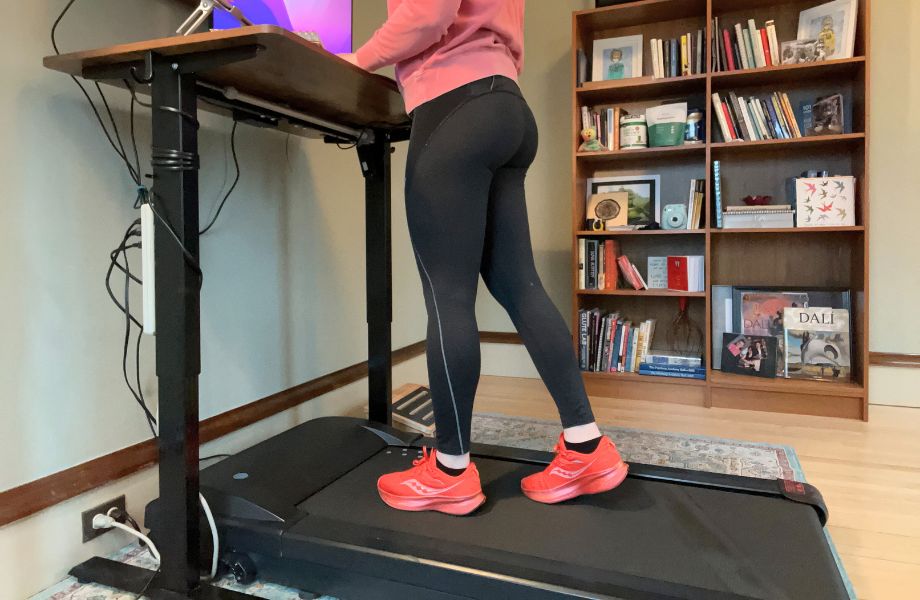We test and review fitness products based on an independent, multi-point methodology. If you use our links to purchase something, we may earn a commission. Read our disclosures.
The under-desk treadmill has tons of traction on TikTok and social media, but you’re probably curious if it’s a fad or a true health hack. All trends aside, there are some solid health benefits of walking on a treadmill and spending less time sitting. In our guide to reaping treadmill desk benefits, I’ll walk you through the potential health perks.
Plus, I’m a certified personal trainer turned full-time fitness writer and consistently use an under-desk treadmill, so stay tuned for some of my personal insights on treadmill desks.
Health Benefits of Walking
Below I’m going to outline the top benefits of walking while you work. I’m personally an advocate of the under-desk treadmill trend and urge anyone with the space (and resources) in your home office to invest in one of the best under-desk treadmills.
While there is not a ton of data on the specific health benefits of under-desk treadmills, we’re going to explore more general treadmill benefits of less time sitting. However, one Occupational Health Science1 study from 2023 notes that research participants who used a treadmill desk while working perceived mental health benefits, higher step counts, and increased physical activity.
Anecdotally, I’m in alignment with these perceived benefits. When I first started using an under-desk treadmill I thought it was rather difficult coordination-wise, but I felt very motivated to keep practicing because I became significantly less active when I left full-time coaching.
When I made the transition to working from home, I experienced a major difference in how my body felt (super stiff), energy levels (low by the end of the day), and my overall mental health and well-being (a general feeling of “meh”). I can honestly say I feel much better (mentally and physically) on the days I incorporate my under-desk treadmill into my workday.
If you’re wondering how to coordinate walking and working, check out our in-depth guide with tricks and tips to working on a treadmill desk.
1. Combats Sedentary Work
You may already know this, but sitting for long periods of time is linked to all-cause mortality2 and metabolic health risks3 like obesity, high blood pressure, and high blood sugar (which can lead to Type 2 diabetes).
You may have even heard about (or read) the 2012 research paper titled, Sitting is the new smoking 4 where researchers outline the human evolution from hunter and gatherer to modern desk jobs and general lack of activity in the current age. The paper indicates prolonged sitting may cause just as many health risks as smoking.
Smoking aside, our sedentary lifestyles alone is a major risk factor for metabolic diseases and premature death. And if you’re an office worker, you’re at a higher risk for these health conditions due to the nature of your work.
This is one of the top reasons office workers are rallying behind the under-desk treadmill: It helps combat the sedentary lifestyle. While research is still limited in this area, a BMC Public Health5 systematic review from 2021 found that walking desks can offer a practical intervention to reduce sitting time and increase energy expenditure and metabolic rate.
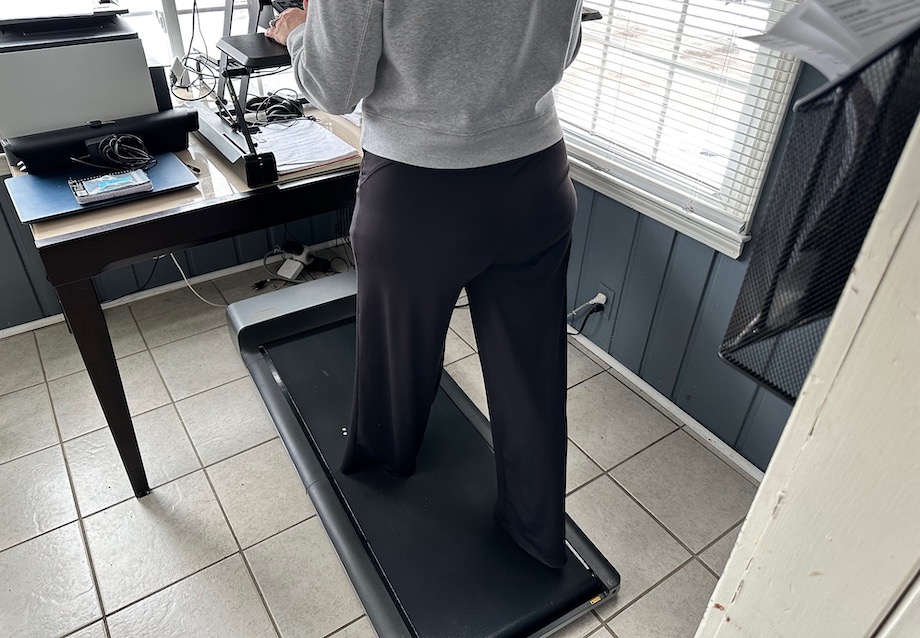
2. Increases Physical Activity
While under-desk treadmill walking is typically slow and low-intensity—not the kind of heart-pumping cardio you’ll do at the gym—it’s still physical activity and non-sitting time. And that low-intensity exercise is categorized as non-exercise activity thermogenesis (aka NEAT6).
NEAT is pretty much all the stuff you do that’s not sleeping, playing sports, or going to the gym. NEAT activity can be anything from walking through a grocery store to gardening in the backyard. Fidgeting, typing, and housework can even be categorized as NEAT. Therefore, walking (even slowly) while you work increases NEAT physical activity and reduces sedentary time.
RELATED: Getting a Move During the Workday
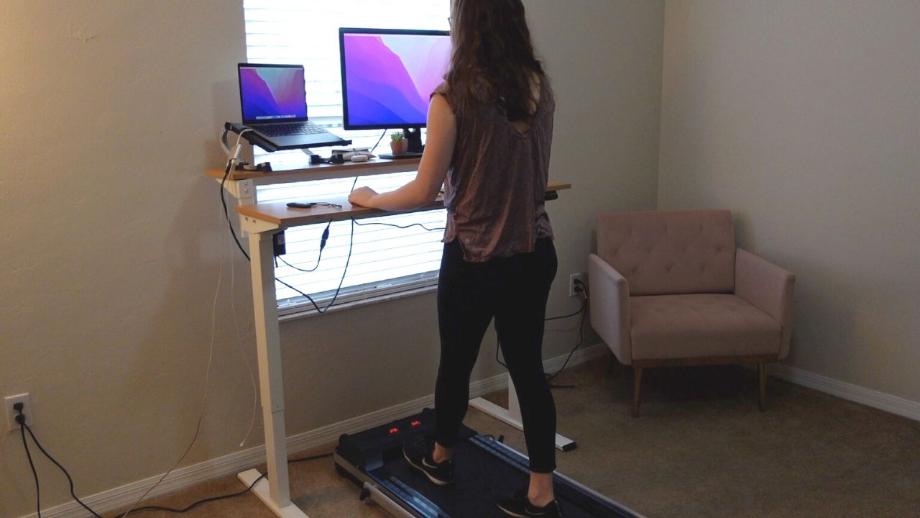
3. May Support Weight Loss
Piggy-backing off of NEAT activity, research from the Journal of Exercise, Nutrition, and Biochemistry7 suggests low levels of NEAT is associated with obesity. Because workouts don’t last all day, non-exercise activity makes up a large portion of your total energy expenditure.
Fidgeting, walking, and general low-intensity activity can increase your energy expenditure and metabolic rate, which helps support weight loss or maintaining a healthy body weight.
RELATED: Activities That Burn the Most Calories
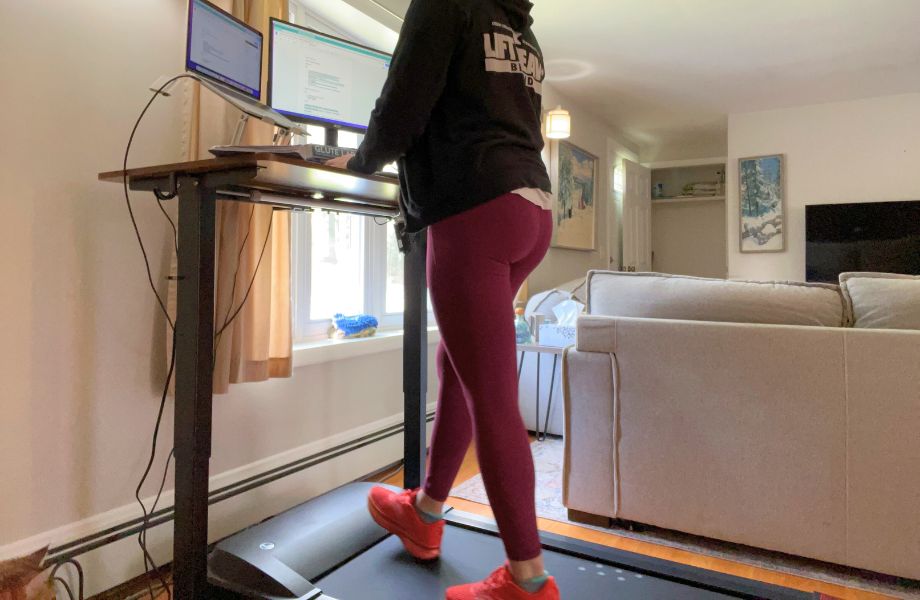
4. May Reduce Your Risk of Heart Disease
Can you sense that more movement (and less sitting) is a theme to overall health? Walking while you work increases your physical activity, which can help combat obesity, which has positive side effects on lowering blood pressure and reducing your risk of cardiovascular disease.
This snowball effect is important because obesity is one of the leading causes of cardiovascular disease and premature death from heart-related conditions8.
RELATED: Tips to Understanding Target Heart Rate
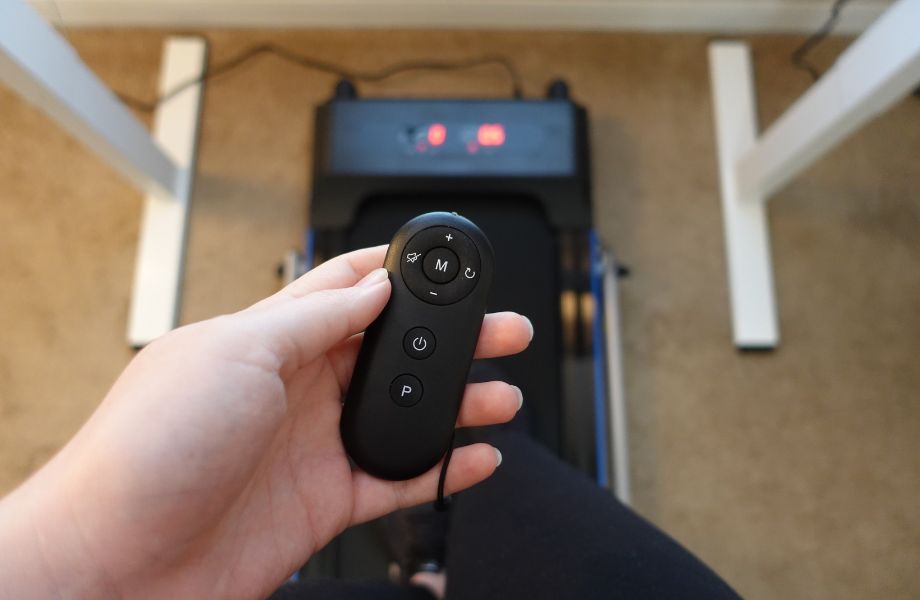
5. Potential to Support Bone Density
Strength training typically gets all the credit in the bone density department, but a 2016 study published by African Health Sciences9 found that treadmill walking was an effective way to stimulate mineral bone density in obese and asthmatic patients.
Most weight-bearing exercise that impacts your skeletal system can help aid new mineral bone formation, which helps your bones become stronger and more dense (including walking, running, jumping and lifting weights).
RELATED: Cardio vs Strength Training
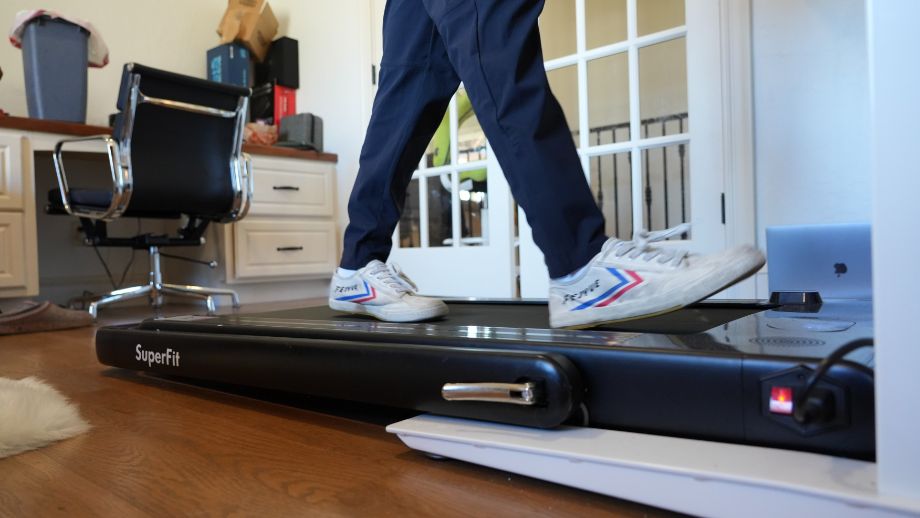
6. May Improve Blood Flow
Walking on a treadmill or other cardio exercise stimulates your heart rate to dilate your blood vessels and increase blood flow throughout the body. Recent research published by Sports Science Health10 suggests that keeping circulation flowing throughout the workday may be an important factor to reducing the “afternoon slump.”
This study wasn’t performed with walking desks, but instead had research participants alternate between standing and sitting throughout the workday. This simple act of decreasing time sitting at a desk led to more cerebral blood flow velocity (which is a fancy way to say blood flow to the brain) throughout the day with significantly less signs of the midday dip than participants who sat all day experienced.
RELATED: Desk-Friendly Office Workout
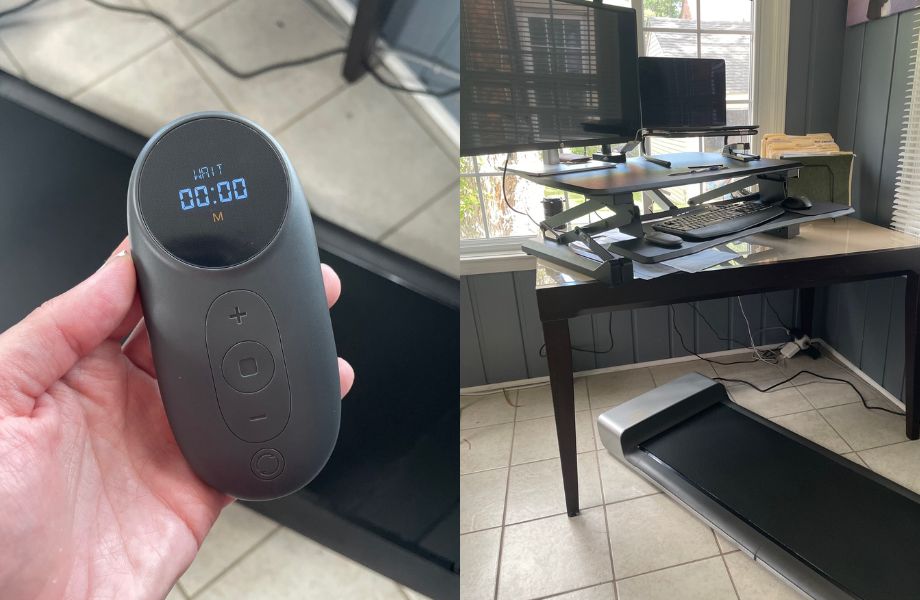
7. Walking May Boost Creative Thinking
A small 2014 study published by the Journal of Experimental Psychology: Learning, Memory, and Cognition11 found that people may be more creative while walking versus sitting. The study found that research participants who walked had more out-of-the-box answers to the Guilford Alternative Uses Test than participants who completed the test while sitting.
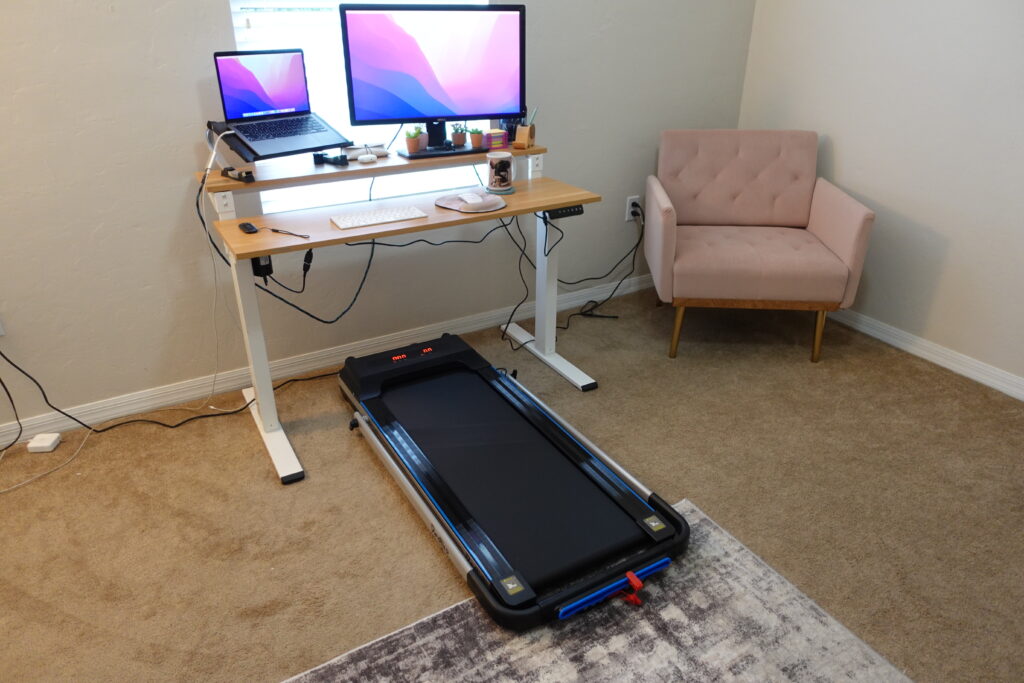
Buying Options for Under-Desk Treadmills and Alternatives
If these above treadmill desk benefits are intriguing, make sure you check out some of our top-rated under-desk treadmill reviews:
- WalkingPad review
- LifeSpan TR1000-DT3 GlowUp Under Desk Treadmill review
- Sunny Health and Fitness Walkstation Slim Flat Treadmill review
- GoPlus 2-in-1 Folding Treadmill review
- Egofit Walker review
- UREVO 2-in-1 Under Desk Treadmill review
- REDLIRO Under Desk Treadmill review
We’ve also tested and reviewed several under-desk treadmill alternatives including:
Treadmill Desk Benefits: Final Thoughts
Walking more and sitting less does in fact have major health benefits. The main takeaway here is that increasing the amount you move throughout the day (and decreasing your time sitting still at a desk) elevates overall energy expenditure and can help prevent premature death.
A treadmill desk may benefit your lifestyle if you:
- Have a desk job or work from home
- Own a standing desk or adjustable height desk
- Find it difficult to get up from your desk to take walks or stretch breaks
- Are wanting to add more activity to your day while you check emails, shop online, watch TV, or listen to music
Treadmill Desk Benefits: FAQs
Is a treadmill desk good for health?
A treadmill desk can help you combat a sedentary lifestyle, which is beneficial because prolonged sitting is linked to premature death and chronic metabolic diseases. A BMC Public Health5 review found that walking desks are a practical way to insert more activity and general movement in an otherwise sedentary workday.
Can you actually work on a treadmill desk?
Yes, you can actually work on a treadmill desk but it will take some time to acclimate to multitasking. Like any new fitness regime, you’ll have to practice. In our guide to working on a treadmill desk, we outline the best practices and tips to getting used to walking and working simultaneously.
Does walking on a desk treadmill help you lose weight?
Walking on a treadmill desk may help you lose weight or maintain a healthy body weight because even slow walking speeds can help you increase your overall energy expenditure throughout the day.
Is it OK to get on the treadmill everyday?
If you’re not experiencing joint or back pain while walking, it’s OK to walk on a treadmill desk every day. Keep in mind you’ll want to gradually increase your walking time and you don’t have to walk all day or for hours on end to reap the benefits of cardio exercise.
References
- Scisco JL, Meyers E, Miceli A, Powell J. “It’s Been a Game Changer”: Examining Treadmill Desk Use When Working from Home. Occup Health Sci. Published online January 28, 2023. doi:10.1007/s41542-023-00144-0
- van der Ploeg HP, Chey T, Korda RJ, Banks E, Bauman A. Sitting time and all-cause mortality risk in 222 497 Australian adults. Arch Intern Med. 2012;172(6):494-500. doi:10.1001/archinternmed.2011.2174
- Edward R. Laskowski, M. D. (2022a, July 13). Sitting risks: How harmful is too much sitting?. Mayo Clinic.
- Baddeley B, Sornalingam S, Cooper M. Sitting is the new smoking: where do we stand?. Br J Gen Pract. 2016;66(646):258. doi:10.3399/bjgp16X685009
- Oye-Somefun A, Azizi Z, Ardern CI, Rotondi MA. A systematic review and meta-analysis of the effect of treadmill desks on energy expenditure, sitting time and cardiometabolic health in adults. BMC Public Health. 2021;21(1):2082. Published 2021 Nov 13. doi:10.1186/s12889-021-12094-9
- Levine JA. Non-exercise activity thermogenesis (NEAT). Best Pract Res Clin Endocrinol Metab. 2002;16(4):679-702. doi:10.1053/beem.2002.0227
- Chung N, Park MY, Kim J, et al. Non-exercise activity thermogenesis (NEAT): a component of total daily energy expenditure. J Exerc Nutrition Biochem. 2018;22(2):23-30. doi:10.20463/jenb.2018.0013
- Akil L, Ahmad HA. Relationships between obesity and cardiovascular diseases in four southern states and Colorado. J Health Care Poor Underserved. 2011;22(4 Suppl):61-72. doi:10.1353/hpu.2011.0166
- Abd El-Kader SM, Al-Jiffri OH, Ashmawy EM, Gaowgzeh RA. Treadmill walking exercise modulates bone mineral status and inflammatory cytokines in obese asthmatic patients with long term intake of corticosteroids. Afr Health Sci. 2016;16(3):798-808. doi:10.4314/ahs.v16i3.2
- Perdomo SJ, Gibbs BB, Kowalsky RJ, Taormina JM, Balzer JR. Effects of Alternating Standing and Sitting Compared to Prolonged Sitting on Cerebrovascular Hemodynamics. Sport Sci Health. 2019;15(2):375-383. doi:10.1007/s11332-019-00526-4
- Oppezzo, M., & Schwartz, D. L. (2014). Give your ideas some legs: The positive effect of walking on creative thinking. Journal of Experimental Psychology: Learning, Memory, and Cognition, 40(4), 1142–1152.
Further reading

A registered sports dietitian worked with a team of fitness professionals to find and test the best sugar-free electrolyte powders on the market today. Read more

The Kabuki Strength Iron Plates are the latest USA-Made weight plate to be released. After training with them for a couple of months and comparing them to the other options available, we feel these are a good, economical plate, but not Kabuki's finest. There are certainly flaws, but the price (when shipping isn't factored) makes them understandable for the value offered. We do recommend them if you're excepting something budget-friendly and understand the downsides. Read more

Our ProForm Performance 400 Treadmill review takes a look at this now-discontinued machine and offers alternatives. Read more

Our X3 Bar review looks at whether this highly-acclaimed home gym system can deliver on the many promises it makes. Read more

